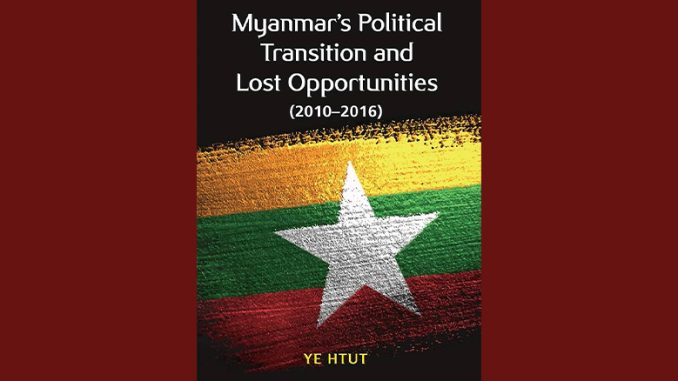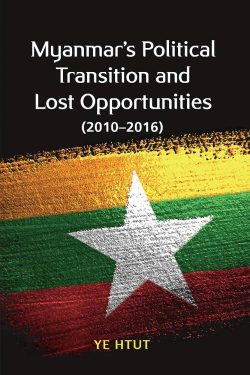
Title: Myanmar’s Political Transition and Lost Opportunities (2010-2016)
Author: Ye Htut
Singapore: ISEAS Publishing, 2019
Myanmar’s February 2021 coup ended decades-long moves towards creating stronger civilian institutions fused to regular electoral opportunities for the Myanmar people to have their say on the country’s future. The coup was an abrupt and devastating blow, especially for young people who had invested so much in their hopes for a better and fairer political system. That system, for all its flaws, grew beyond the expectations of the 2008 constitution drafted on the say-so of the old dictatorial elite. Somebody who knows that elite well, and has spent much of his life serving their interests, has now written an unusual and compelling account of the political changes that occurred from 2010-2016.
Under President Thein Sein, Ye Htut was the Deputy Minister of Information and then the Presidential Spokesperson before being promoted to serve as Minister of Information from 2014-16. With this background, the discussion of his old portfolio responsibilities proves particularly interesting. He even includes the PowerPoint slides (pp.190-191) sketching out the short, medium, and long-term “roadmaps” for media reform dating back to 2008. It is one of the positive stories now obliterated by the 2021 coup. Before the coup, as a Visiting Senior Research Fellow at the ISEAS – Yusof Ishak Institute in Singapore, Ye Htut wrote this account of what he calls the “positive legacy of President Thein Sein and his democratic reforms” (p. 225). The book includes a lengthy contextual essay by Robert H. Taylor, who has been publishing prolifically and with insight into Burma/Myanmar affairs since the 1970s. Ye Htut acknowledges Taylor “has always challenged my assumptions about Myanmar’s politics” (p.xix).
As a former Army Lieutenant Colonel and then senior propaganda official during the final years of the Senior General Than Shwe-led military dictatorship, Ye Htut worked closely with all of the top military figures of this period. The book is meticulously footnoted, with facts and interpretations drawn from interviews with many key players: there are 26 named interviewees, including former military intelligence chief Khin Nyunt, “hard-line” Amyotha Hluttaw speaker Khin Aung Myint (p.189), speaker of the Pyithu Hluttaw Shwe Mann, and the “not…ambitious” (p. 219) Preident Thein Sein, alongside forty-four anonymous interviewees who are all assigned code numbers. The book includes good photographs, some from Ye Htut’s private collection, including President Thein Sein in unguarded moments, and others from the collection of the Ministry of Information.
Ye Htut’s descriptions of the Thein Sein Presidency are defined by the fact that he is writing from a position of proximity, even intimacy, to the issues, events, and players he describes. When Ye Htut writes that “Shwe Mann showed deep respect for Than Shwe and Than Shwe appreciated Shwe Mann’s manner” (p. 105) it is more than a passing observation. The footnoted source is Shwe Mann’s son, Toe Naing Mann. Much of the book’s discussion focuses on the fraught relationship between President Thein Sein and Shwe Mann. A key point is that “[w]ith his political ambitions, wealth and manipulation of MPs and the media, Shwe Mann became a thorn in President Thein Sein’s side after 2012” (p. 114). From this perspective “six major incidents took place between 2011 and 2016 in which Shwe Mann tried to weaken the president and undermine his power” (p. 123).
 It is notable that in this 259-page book Senior General Min Aung Hlaing, the Commander-in-Chief from 2011, is hardly mentioned. Instead, the book lingers on the dynamics between Shwe Mann and Thein Sein, and the looming figure of Than Shwe. Ye Htut ends by reflecting, somewhat remarkably, on the “mistakes” (pp.216-217) made by former Senior General Than Shwe, especially concerning his management of Shwe Mann and President Thein Sein. Ye Htut even tells us that “Than Shwe said Thein Sein was weak, Shwe Mann was a traitor, and Soe Thane and Aung Min [both senior Ministers] acted as CIA agents” (p. 217). The source for these assertions are interviews 010 and 020.
It is notable that in this 259-page book Senior General Min Aung Hlaing, the Commander-in-Chief from 2011, is hardly mentioned. Instead, the book lingers on the dynamics between Shwe Mann and Thein Sein, and the looming figure of Than Shwe. Ye Htut ends by reflecting, somewhat remarkably, on the “mistakes” (pp.216-217) made by former Senior General Than Shwe, especially concerning his management of Shwe Mann and President Thein Sein. Ye Htut even tells us that “Than Shwe said Thein Sein was weak, Shwe Mann was a traitor, and Soe Thane and Aung Min [both senior Ministers] acted as CIA agents” (p. 217). The source for these assertions are interviews 010 and 020.
On other contentious issues, Ye Htut chooses his words carefully. At one stage, he summarises the consequences of violence in Rakhine State in dot points. He tells us that “the Bengalis demanded to be described as ‘Rohingya’ on their national identity cards” (p.180). He goes on to explain that “[a]s the 2015 election loomed, the government became more reluctant to deal with the Rakhine issue or to stop the extremist ant-Muslim agitation of some Buddhist monks” (p. 181). It is hard to know what Ye Htut really thinks on this topic and a few others.
With everything that has happened since the coup, Ye Htut’s book deserves a sequel, one that engages directly with the NLD’s years in government, with the military’s responses through that period, and ultimately with the decisions that led to the 2021 coup. In the current volume, the lack of attention to the roles of uniformed military personnel from 2010-2016 is a striking omission. Where were the key coup-makers throughout this period? Did President Thein Sein and Shwe Mann consider a future where their investments in the institutions of executive and legislative power would be wiped away by their former army subordinates? At what cost could such actions be justified?
Ye Htut describes the hard power politics of the 2010-2016 period in terms of the highly personalised insider dynamics of the walled compounds of Naypyitaw. It is a world that few others have seen with such clarity and consistency. Read alongside Andrew Selth (2021), Maung Aung Myoe (2009), Renaud Egreteau (2022) and Melissa Crouch (2019), Myanmar’s Political Transition is therefore a valuable addition to our understanding of a tumultuous period in Myanmar politics. While we may want to find fault with both the priorities of the players and the structures of their flawed political reform project, thanks to Ye Htut we have a new resource that can help explain what happened and why.
Reviewed by Nicholas Farrelly
Nicholas Farrelly is Professor and Head of Social Sciences at the University of Tasmania. He was previously an Associate Dean in the College of Asia and the Pacific at the Australian National University. From 2015-2018 he was the first Director of the ANU Myanmar Research Centre. nicholas.farrelly@utas.edu.au
References
Crouch, M. (2019). The Constitution of Myanmar : A Contextual Analysis. London: Bloomsbury.
Egreteau, R. (2022). Crafting Parliament in Myanmar’s Disciplined Democracy (2011-2021). Oxford: Oxford University Press.
Maung Aung Myoe (2009) Building the Tatmadaw: Myanmar armed forced since 1948. Singapore: Institute of Southeast Asian Studies.
Selth, A. (2021). Myanmar’s military mindset: An exploratory survey. Brisbane: Griffith Asia Institute. Available from: https://www.griffith.edu.au/__data/assets/pdf_file/0023/1418333/Military-mindset-web.pdf
